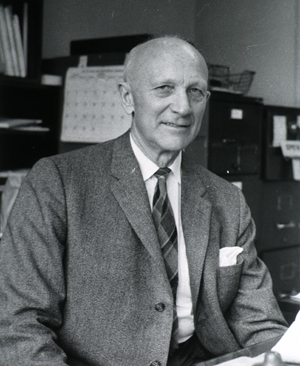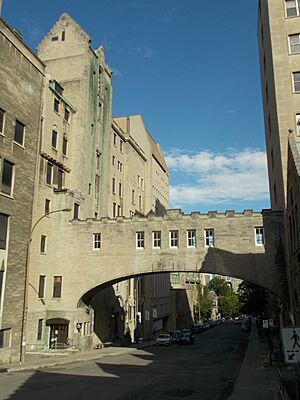Wilder Penfield facts for kids
Quick facts for kids
Wilder Penfield
|
|
|---|---|

Penfield in 1958
|
|
| Born |
Wilder Graves Penfield
January 26, 1891 Spokane, Washington, United States
|
| Died | April 5, 1976 (aged 85) Montreal, Quebec, Canada
|
| Alma mater |
|
| Known for |
|
| Awards |
|
| Scientific career | |
| Fields | Neurosurgery |
| Institutions |
|
| Notable students | Laurence Levy |
Wilder Graves Penfield OM CC CMG FRS (January 26, 1891 – April 5, 1976) was a famous brain surgeon from both America and Canada. He made brain surgery much better and found out what different parts of the brain do. He even created a "map" of how our body parts are connected to our brain. He also studied how stimulating the brain could cause things like seeing or hearing things that aren't there (hallucinations), strange feelings, or the feeling of déjà vu (feeling like you've already experienced something). Penfield spent a lot of time thinking about how our minds work.
Contents
About Wilder Penfield
His Early Life and Schooling
Wilder Penfield was born in Spokane, Washington, on January 26, 1891. He grew up mostly in Hudson, Wisconsin. He went to Princeton University, where he played on the football team. After graduating in 1913, he even coached the team for a short time.
In 1915, he won a special scholarship called a Rhodes Scholarship to study at Merton College, Oxford in England. There, he learned about brain diseases. During World War I, he worked in a military hospital in France and was hurt when his ferry was attacked.
The next year, he married Helen Kermott. He then went to Johns Hopkins School of Medicine and became a doctor in 1918. He continued his studies in England and Germany, learning from top doctors. In 1928, he learned how to keep patients awake during brain surgery using local anesthesia. This was very important for his later work.
His Amazing Medical Career
After training with another famous surgeon, Harvey Cushing, Penfield started doing his own brain operations. He treated people with epilepsy, a condition that causes seizures. He met David Rockefeller, who wanted to help Penfield create a special institute to study epilepsy surgery.
In 1928, Penfield moved to Montreal, Quebec, Canada. He became Montreal's first brain surgeon and taught at McGill University.
In 1934, Penfield helped start the Montreal Neurological Institute and Hospital at McGill University. This institute was built with money from the Rockefeller Foundation. That same year, he became a British citizen, as Canada was part of the British Empire at the time.
Penfield's only sister, Ruth, sadly died from brain cancer. Even though he performed complex surgery, he could not save her, but he did add years to her life.
Penfield retired in 1960. He then focused on writing books, including a novel and his autobiography. He received many awards for his work, including the Order of Merit and the Order of Canada. His old papers and notes are kept at the Osler Library at McGill University.
Later Life and Public Service
In his later years, Penfield cared a lot about public education. He helped create the Vanier Institute of the Family. This group helps families and supports learning at home, which he called "man's first classroom." He also believed that children should learn two languages from a young age.
Wilder Penfield passed away on April 5, 1976, from cancer in Montreal. He and his wife, Helen, are buried on their family property in Quebec.
Wilder Penfield's Discoveries
How He Studied the Brain
Penfield was a truly groundbreaking surgeon and researcher. He invented a special tool called the Penfield dissector. This tool helped surgeons operate on the brain with less damage, and it's still used today!
With his friend Herbert Jasper, he developed the "Montreal Procedure." This was a way to treat severe epilepsy. During surgery, patients were awake (they only had local anesthesia). Penfield would gently touch parts of their brain with an electrical probe. He watched their reactions carefully. This allowed him to find the exact areas of the brain causing the seizures. By removing only those specific cells, he could reduce the side effects of the surgery.
This method also helped him create "maps" of the brain's sensory and motor areas. These maps showed which parts of the brain control different body parts, like your hands or feet. He called this the "cortical homunculus." These maps are still used by doctors today, almost exactly as Penfield drew them. His work greatly helped us understand how different parts of the brain have different jobs.
Penfield also found that stimulating the temporal lobe of the brain could make people vividly remember old memories. Sometimes, people think this means our brains record everything perfectly, but Penfield later updated his ideas on this. Only a small number of his patients experienced this memory recall.
Understanding Hallucinations
Penfield's work wasn't just about movement and touch. He also explored the functions of the parietal and temporal cortices, which are involved in things like memory and perception.
Out of 520 patients, 40 reported strange experiences when their temporal lobe was stimulated. They might recall dreams, smell things, or have visual or auditory hallucinations (seeing or hearing things that aren't there). Some even felt like they were outside their own body. These experiences only lasted as long as the electrical stimulation was on the brain. Sometimes, patients would smell certain things, see flashing lights, or feel a hand stroking them. Other times, they felt déjà vu, fear, loneliness, or strangeness.
Penfield called these "interpretive responses." He said that when the temporal lobe was stimulated, patients had two types of experiences:
- Experiential experience: Where the patient heard a song or saw a flash of light.
- Strip experience: A memory that felt familiar, even if the patient couldn't remember the exact time it happened. This recall could bring back the feelings linked to that memory.
Penfield believed that the things we remember clearly are the things we paid close attention to. He spent over 25 years using electrical brain stimulation to study these experiences. His research showed that hallucinations can range from simple to complex, and they can be triggered by stimulating specific brain areas.
The Mystery of Déjà Vu
Penfield also studied déjà vu, which is that strange feeling that you've already experienced something, even if it's new. Most people between 15 and 25 years old experience déjà vu, affecting about 60-70% of people.
One idea is that déjà vu happens when our brain's sensory input doesn't quite match up with how it recalls memories. Another idea is that there's a small mix-up in how our short-term and long-term memories work, causing new memories to feel old. Our memory is good at recognizing objects, but not always at remembering how things are arranged. Déjà vu is an intense feeling of familiarity in a completely new situation.
While déjà vu is common, it can sometimes be linked to epilepsy or other brain conditions. In people with temporal lobe epilepsy, the brain's neurons (nerve cells) might misfire. This can create a false feeling of having experienced a situation before.
Researchers often divide déjà vu into two types:
- Associative déjà vu: This is what healthy people experience when something reminds them of a past event.
- Biological déjà vu: This happens to people with temporal lobe epilepsy, often right before a seizure.
There's also a rare condition called chronic déjà vu, where someone feels like they are constantly experiencing déjà vu. This might happen if the brain circuits connected to memories get stuck in an "active" state, creating memories that never actually occurred.
His Lasting Impact
Wilder Penfield was named a National Historic Person by the Canadian government in 1988. There's a special plaque at a building named after him at McGill University in Montreal.
Canada Post even issued a postage stamp honoring Penfield on March 15, 1991.
A street in Montreal, Avenue du Docteur-Penfield, was named after him in 1978. It's near McGill University.
A painting of Wilder Penfield hangs in Rhodes House at the University of Oxford in England. He was also made a Fellow of the Royal Society in the United Kingdom in 1943.
To honor his work in education, an elementary school called Wilder Penfield Elementary School was named after him. One of the buildings at John Abbott College also carries his name.
On January 26, 2018, Google featured Wilder Penfield in a special "Google doodle" to celebrate his 127th birthday.
The Penfield Children's Center in Milwaukee, Wisconsin, is named after Dr. Penfield. This center helps children with developmental delays and disabilities, reflecting his support for early help for kids.
Things Named After Penfield
- Penfield's homunculus: The "map" of how our body parts are connected to the brain, which Penfield first described in 1937.
- Penfield syndrome: A type of epileptic seizure that affects the body's automatic functions.
- Penfield dissector: A special surgical tool used in brain surgery and other operations.
Honorary Degrees
Wilder Penfield received many special degrees from universities to honor his medical career.
| Location | Date | School | Degree |
|---|---|---|---|
| 1939 | Princeton University | Doctor of Science (D.Sc.) | |
| October 30, 1946 | University of British Columbia | Doctor of Science (D.Sc.) | |
| September 29, 1959 | University of Saskatchewan | Doctor of Laws (LL.D) | |
| 1953 | University of Toronto | Doctor of Science (D.Sc.) | |
| 1953 | University of Oxford | --- | |
| 1955 | University of Manitoba | Doctor of Science (D.Sc.) | |
| 1957 | Queen's University | Doctor of Laws (LL.D) | |
| October 6, 1960 | McGill University | Doctor of Science (D.Sc.) | |
| / | Bishop's University | Honorary Graduate | |
| May 1962 | McMaster University | Doctor of Science (D.Sc.) | |
| March 29, 1967 | University of Calgary | --- | |
| May 16, 1970 | Royal Military College of Canada | Doctor of Science (D.Sc.) | |
| September 21, 1972 | University of Western Ontario | Doctor of Science (D.Sc.) |
Selected Books by Penfield
- Epilepsy and Cerebral Localization: A Study of the Mechanism, Treatment and Prevention of Epileptic Seizures. By Wilder Penfield and Theodore C. Erickson. Charles C. Thomas, 1941.
- Epileptic seizure patterns; a study of the localizing value of initial phenomena in focal cortical seizures. Penfield, Wilder; Kristiansen, Kristian (1951).
- Epilepsy and the Functional Anatomy of the Human Brain. 2nd edition. Jasper, H., and Penfield, W. Little, Brown and Co., 1954.
- Speech and Brain Mechanisms, Penfield, Wilder and Roberts, Lamar, Princeton University Press, 1959.
- The Torch, a story of Hippocrates. Penfield, W. Little, Brown and Co.; 1960. (This is a historical novel about Hippocrates, an ancient Greek doctor.)
- The Mystery of the Mind : A Critical Study of Consciousness and the Human Brain. Penfield, Wilder. Princeton University Press, 1975.
- No Man Alone: A Neurosurgeon's Life, Little, Brown and Co., 1977. (This is Penfield's autobiography, telling his life story.)




